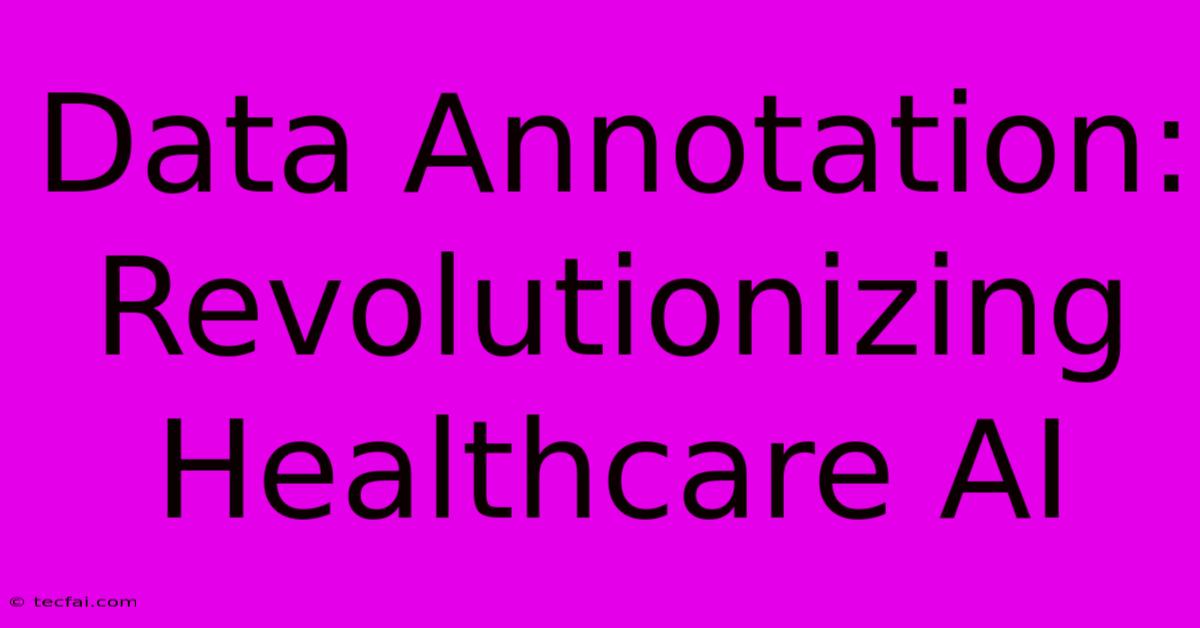Data Annotation: Revolutionizing Healthcare AI

Discover more detailed and exciting information on our website. Click the link below to start your adventure: Visit Best Website tecfai.com. Don't miss out!
Table of Contents
Data Annotation: Revolutionizing Healthcare AI
The healthcare industry is experiencing a dramatic transformation, fueled by the rise of Artificial Intelligence (AI). AI-powered tools promise to revolutionize diagnostics, treatment, and patient care, but their effectiveness hinges on one crucial element: high-quality data annotation. This process, the meticulous tagging and labeling of medical data, is the unsung hero driving the advancements in healthcare AI. Without accurate and comprehensive annotation, even the most sophisticated algorithms remain ineffective. Let's delve into how data annotation is revolutionizing this vital sector.
The Crucial Role of Data Annotation in Healthcare AI
AI algorithms learn from data. In healthcare, this data can include medical images (X-rays, CT scans, MRIs), electronic health records (EHRs), genomic sequences, and more. However, raw data is meaningless to an AI. Data annotation provides the context and meaning, enabling the algorithm to understand and learn from the information. This involves tasks such as:
- Image Annotation: Identifying and labeling specific features within medical images, such as tumors, lesions, or anatomical structures. This often involves techniques like bounding boxes, polygons, semantic segmentation, and landmarking.
- Text Annotation: Labeling and categorizing information within EHRs, clinical notes, and research papers. This might involve Named Entity Recognition (NER) to identify patient information, diagnoses, and treatments.
- Audio Annotation: Transcribing and classifying audio recordings of patient consultations or heart sounds to assist in diagnosis and monitoring.
- Video Annotation: Analyzing surgical videos to identify key steps in procedures or track instrument movements.
These annotation processes are painstaking and require specialized expertise. The accuracy of the annotation directly impacts the accuracy and reliability of the resulting AI models. Inaccurate annotations can lead to misdiagnosis, incorrect treatment plans, and potentially harm patients.
Types of Data Annotation in Healthcare
The complexity of healthcare data necessitates a variety of annotation techniques:
1. Bounding Boxes:
Used extensively in image annotation, bounding boxes create rectangular boxes around objects of interest within an image. This is a relatively simple but effective method for object detection.
2. Polygons:
Provide more precise annotation than bounding boxes, particularly for irregularly shaped objects. Polygons are frequently used to delineate the boundaries of lesions or tumors in medical images.
3. Semantic Segmentation:
Goes beyond simple object identification by assigning a label to every pixel in an image. This provides a detailed understanding of the image's composition and is crucial for tasks like automated image analysis.
4. Landmarking:
Involves identifying and labeling specific points within an image, often used to mark anatomical structures or key features for accurate measurement and analysis.
The Impact of Data Annotation on Healthcare AI Applications
The implications of accurate data annotation are far-reaching:
- Improved Diagnostic Accuracy: AI algorithms trained on accurately annotated data can detect diseases earlier and more accurately than human experts in some cases, leading to improved patient outcomes.
- Personalized Medicine: By analyzing annotated patient data, AI can tailor treatment plans to individual needs, maximizing efficacy and minimizing side effects.
- Drug Discovery and Development: AI can accelerate drug discovery by analyzing annotated genomic and chemical data, identifying potential drug candidates and predicting their efficacy.
- Streamlined Workflow: Automated annotation tools can improve efficiency in hospitals and clinics, freeing up healthcare professionals to focus on patient care.
Challenges and Future Trends in Healthcare Data Annotation
Despite its importance, healthcare data annotation faces several challenges:
- Data Scarcity: High-quality, annotated medical data is often scarce, limiting the ability to train robust AI models.
- Data Privacy and Security: Protecting patient data is paramount, requiring stringent security measures throughout the annotation process.
- Annotation Cost and Time: The process is labor-intensive and requires skilled annotators, making it expensive and time-consuming.
Future trends include the development of more sophisticated annotation tools, the use of synthetic data to augment real-world datasets, and the exploration of automated annotation techniques to increase efficiency and reduce costs. The development of robust and ethical AI solutions in healthcare is deeply intertwined with the quality and quantity of annotated data. As technology advances, data annotation will continue to play a vital role in shaping the future of healthcare.

Thank you for visiting our website wich cover about Data Annotation: Revolutionizing Healthcare AI. We hope the information provided has been useful to you. Feel free to contact us if you have any questions or need further assistance. See you next time and dont miss to bookmark.
Featured Posts
-
Hutchs Dublin Central 2024 Election Outcome
Nov 30, 2024
-
Best Black Friday Gaming Deals 2024
Nov 30, 2024
-
Western Sydney Couple Dies
Nov 30, 2024
-
Kyk Brighton Vs Southampton Premierliga Stroom
Nov 30, 2024
-
Bob Bryar My Chemical Romance Drummer Dies At 44
Nov 30, 2024
